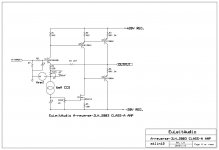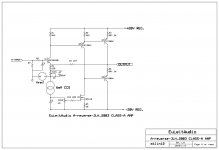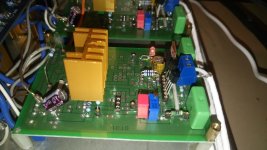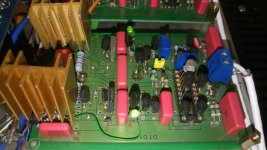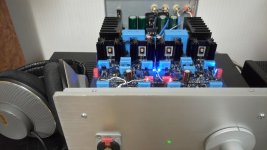This morning I try to change some MOSFETs to BJTs, and the circuit looks like this, some were not changed to fit in my old PCBs.
2nd stage's CCS I still prefer using MOSFET, R5's value is not yet settled, I have several 0.1% of PHILIPS 100 ohm, best for measurement.
Thanks again N101N.
2nd stage's CCS I still prefer using MOSFET, R5's value is not yet settled, I have several 0.1% of PHILIPS 100 ohm, best for measurement.
Thanks again N101N.
Attachments
2SK214 is now also difficult.
So for others one can just use a DN2540 with a trimmable source resistor as current source.
Self biasing.
Cheers,
Patrick
Thanks, I have DN3545 but not many, and it often breakdown, I prefer using IRF610 instead though the Vgs is much higher than 2SK214, so I'm thinking lower the R5 to 50 ohm.
Attachments
Last edited:
A high Vgs of the MOSFET does not mean a similarly high minimum headroom (Vds) of the CCS.
See figure 2 of the Vishay IRF610 datasheet.
Patrick
Another thing is power dissipation, my DN3545 is TO-92 package, IRF610 is TO-220AB much better than DN3545 or DN2540.
I'd strongly suggest using bsp-bss depletion mode mos-fets from infineon(siemens) for CCS.Very cheap end incredibly linear in only one transistor per ccs.No need for fussy cascodes.I'm using them for a few years now in everything and they perform flawlessly.What's more interesting is that measuring 20 transistors in a batch, for the same drain resistor you have perfectly identical currents in all samples and i measured each of them for aprox 15 different currents.You need to do it anyway to determine which class are they into the subtreshold bias region.DN3545 + LM334Z and a diode
http://www.euleitaudio.com/images/EU-01_MKII/EuLeit_EU-01_MKII_Preamp_V2.2_WO_SCH.jpg
My DN2540's are TO220.
But I always prefer JFET for CCS due to lower noise.
For example a cascoded 2SK246 degenrated to 2mA has exceptional dynamic resistance.
Patrick
I like JFET CCS too, but right now normally I use DN3545+2SK170 cascode type for higher Vds needs, also provide higher current.
LM334Z has higher noise only no need to be trimmed, so I still use DN3545+LM334Z+Diode to lower tempco.
but have to add a 0.1uF to lower the noise.
I'd strongly suggest using bsp-bss depletion mode mos-fets from infineon(siemens) for CCS.Very cheap end incredibly linear in only one transistor per ccs.No need for fussy cascodes.I'm using them for a few years now in everything and they perform flawlessly.What's more interesting is that measuring 20 transistors in a batch, for the same drain resistor you have perfectly identical currents in all samples and i measured each of them for aprox 15 different currents.You need to do it anyway to determine which class are they into the subtreshold bias region.
Many thanks.
From my own experience with the JLH topology, both with the above mentioned FET version and with BJTs
https://www.diyaudio.com/forums/solid-state/3075-jlh-10-watt-class-amplifier-142.html#post942914
there is IMHO no use just to have zero tempco with the CCS.
Everything else drifts anyway with temperature.
Vbe and hfe (hence base / collect current) of BJTs, Vgs or Id of MOSFETs, Idss of JFETs, ....
It is almost impossible to make the entire circuit thermally neutral.
So for peace of mind, either one uses the Cii in the feedback loop, or adds a servo.
Or one trims the DC and bias at steady state after 1 hour, and accept the lower bias / high DC at cold start.
Perhaps you have a different experience ?
Patrick
https://www.diyaudio.com/forums/solid-state/3075-jlh-10-watt-class-amplifier-142.html#post942914
there is IMHO no use just to have zero tempco with the CCS.
Everything else drifts anyway with temperature.
Vbe and hfe (hence base / collect current) of BJTs, Vgs or Id of MOSFETs, Idss of JFETs, ....
It is almost impossible to make the entire circuit thermally neutral.
So for peace of mind, either one uses the Cii in the feedback loop, or adds a servo.
Or one trims the DC and bias at steady state after 1 hour, and accept the lower bias / high DC at cold start.
Perhaps you have a different experience ?
Patrick
Bsp-smd, bss-through hole.I used them in bootstrapped voltage sources and current sources for the first valve stage in phono preamps (passive network-way noisier than FB networks ) and the noise was acceptable to me. 1V2 phono riaa preamplifier The passive version was executed and i liked the sound .The active one...i'm still working on the design before execution, but i'm confident that it will do an over-engineering job  The first bipolar version was dead quiet at max level without a cartridge mounted at the input though... UNU-pnono riaa mm preamp
The first bipolar version was dead quiet at max level without a cartridge mounted at the input though... UNU-pnono riaa mm preamp
At line levels i have no doubt that it can be the perfect choice for anything.I used them also in a high voiltage esl headphones amplifier that got to CES in 2016...so i think they are great pieces of technology.
At line levels i have no doubt that it can be the perfect choice for anything.I used them also in a high voiltage esl headphones amplifier that got to CES in 2016...so i think they are great pieces of technology.
Last edited:
From my own experience with the JLH topology, both with the above mentioned FET version and with BJTs
https://www.diyaudio.com/forums/solid-state/3075-jlh-10-watt-class-amplifier-142.html#post942914
there is IMHO no use just to have zero tempco with the CCS.
Everything else drifts anyway with temperature.
Vbe and hfe (hence base / collect current) of BJTs, Vgs or Id of MOSFETs, Idss of JFETs, ....
It is almost impossible to make the entire circuit thermally neutral.
So for peace of mind, either one uses the Cii in the feedback loop, or adds a servo.
Or one trims the DC and bias at steady state after 1 hour, and accept the lower bias / high DC at cold start.
Perhaps you have a different experience ?
Patrick
Yes, plenty of them , FETs, BJTs even PCB & RELAYs blow many times all about thermal problems, not because of oscillation.
Like diamond-output-buffer-eats-trannies-thermal.html
Before these designs, normally I use differntial DUAL-JFET (LS-844 or 2N5566) input with NFB design, so thermal problems can be easilly controlled.
But when SPLIT or Power Buffer design is different, without total NFB sometimes it just get burned very quickly, maybe within 10 min.
Zero DC-coupled design is difficult without NFB, JLH-2003 fortunately quite easy to set to "zero".
Although a big defender of Jung's articles on highly linear CCS or other fancy circuits using obsolete or expensive components, the more i try and listen to old technology the more i understand that good sound is not linked to over engineered exotic electronics.Almost everybody in the diy main stream forgot of capacitor coupled stages while they solve so many problems in such an elegant way...sub 10 hertz to 1 megahertz bandwidth became main stream while 30hz to 15 khz is enough for everybody on earth, Now they need cascodes and diamonds everywhere in their designs, but high speed liniar circuits with zero tempco is not a guarantee for good sounding circuits at all.It's just main stream delusion...When you get to understand that a 3 components circuit can sound better than one using 50 components...that's big dissappointment.
Although a big defender of Jung's articles on highly linear CCS or other fancy circuits using obsolete or expensive components, the more i try and listen to old technology the more i understand that good sound is not linked to over engineered exotic electronics.Almost everybody in the diy main stream forgot of capacitor coupled stages while they solve so many problems in such an elegant way...sub 10 hertz to 1 megahertz bandwidth became main stream while 30hz to 15 khz is enough for everybody on earth, Now they need cascodes and diamonds everywhere in their designs, but high speed liniar circuits with zero tempco is not a guarantee for good sounding circuits at all.It's just main stream delusion...When you get to understand that a 3 components circuit can sound better than one using 50 components...that's big dissappointment.
Circuit that sounds good or not is very tricky, some 0.1%THD just "better" than 0.0001% , and similar like slew rate 10V/uS "better" than 1000V/uS...
IMHO, just like Chinese said "THIN woman is beautiful in HAN Dynasty, but FAT woman is more beatiful in TAN Dynasty", there is no fixed standard. Only the Audio measurements still have some problems about "GOOD" sound, they are just too complicate when several freqs come in together at the same time, how can machines test their THD.
Some expensive components may have good material quality, but garanty have good sound? I'm not so sure! My new Pre-amp if take away with the input cascode DN3545 (Pure for +/- 60V needs), only 3 normal FETs, and my DB-01 designed 15years ago use more than 30 of all kinds FETs and BJTs, butwhen I asked my customers about the sound, they all said with HOLCO resistors' version EU-01 is "much" better than DB-01 with PHILIHS resistors.
Seeing is believing!
But now I think maybe the new one with 4 FETs maybe sounds more like TUBE, and more "LIVE", but it should have more distortion than the 0.001%-OLD one!
Hearing is believing?
Attachments
Last edited:
> Hearing is believing?
Yes, but in general you cannot go much wrong with simple topologies in Class A and using FETs.
Having said that the Pioneer Super Linear we built also sounds very nice.
It does have some correction mechanism though for the BJT characteristics.
And it also has very low distortion even without global NFB.
The Pioneer Super Linear Circuit
So 0.1% distortion also does not necessarily mean good sound.
Patrick
Yes, but in general you cannot go much wrong with simple topologies in Class A and using FETs.
Having said that the Pioneer Super Linear we built also sounds very nice.
It does have some correction mechanism though for the BJT characteristics.
And it also has very low distortion even without global NFB.
The Pioneer Super Linear Circuit
So 0.1% distortion also does not necessarily mean good sound.
Patrick
> Hearing is believing?
Yes, but in general you cannot go much wrong with simple topologies in Class A and using FETs.
Having said that the Pioneer Super Linear we built also sounds very nice.
It does have some correction mechanism though for the BJT characteristics.
And it also has very low distortion even without global NFB.
The Pioneer Super Linear Circuit
So 0.1% distortion also does not necessarily mean good sound.
Patrick
I agree with your opinion! In Taiwan or in China, there are many people who are always looking for beautiful data, but they ignore the sound.
For a truly high-end design engineer, he must have a high degree of musical appreciation, and use his ears to heard, as the data is only used as a reference for design.
- Status
- This old topic is closed. If you want to reopen this topic, contact a moderator using the "Report Post" button.
- Home
- Amplifiers
- Solid State
- Another JLH, my 2SJLH PMOSFET DC Class-A amp
